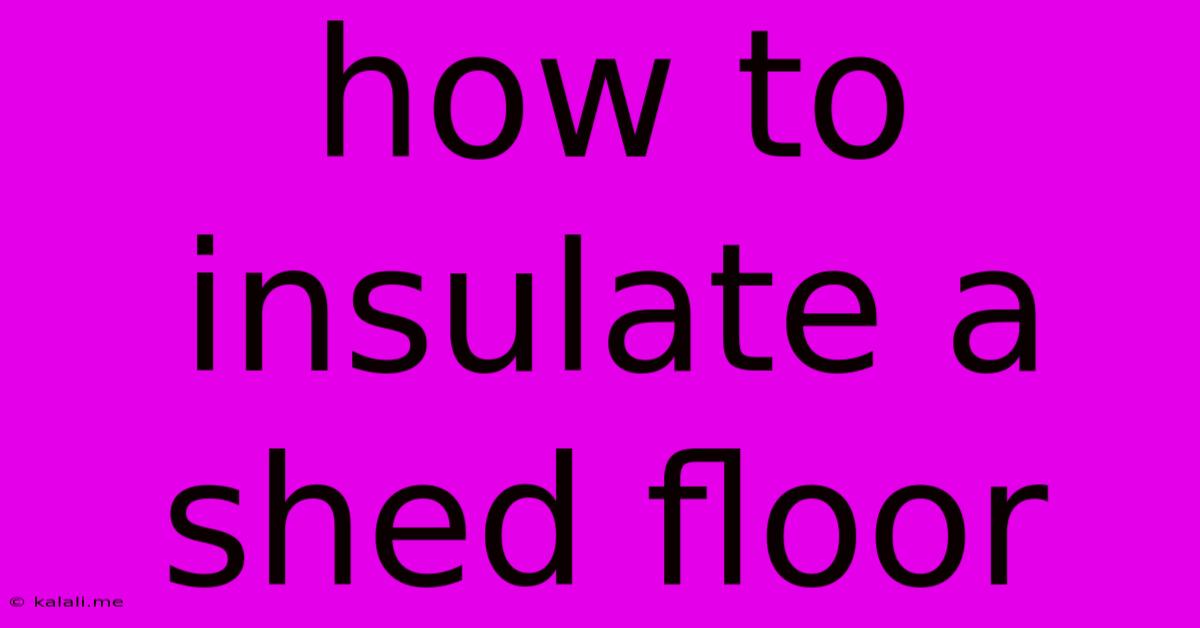How To Insulate A Shed Floor
Kalali
May 21, 2025 · 3 min read

Table of Contents
How to Insulate a Shed Floor: A Comprehensive Guide
Meta Description: Transform your chilly shed into a cozy workspace! This comprehensive guide details how to effectively insulate your shed floor, improving comfort and extending usability year-round. Learn about different insulation types, installation methods, and crucial considerations for a successful project.
Insulating your shed floor is a worthwhile investment that significantly enhances its usability and comfort, especially during colder months. A well-insulated floor prevents heat loss, keeps the interior warmer, and creates a more pleasant environment for working, storing items, or even relaxing. This guide will walk you through the process, covering everything from choosing the right insulation to completing the installation.
Choosing the Right Insulation
The first step is selecting the appropriate insulation material. Several options are available, each with its pros and cons:
-
Rigid Foam Boards (e.g., XPS, EPS): These are excellent choices due to their high R-value (a measure of thermal resistance) and ease of installation. XPS (extruded polystyrene) is more moisture-resistant than EPS (expanded polystyrene). They're relatively inexpensive and durable.
-
Kingspan Kooltherm: This is a premium rigid insulation often used in situations where a thin profile is important. It delivers exceptional insulation per inch and is waterproof.
-
Insulation Rolls (e.g., mineral wool, fiberglass): These are flexible and can conform to uneven surfaces. Mineral wool offers good fire resistance, while fiberglass is more affordable but can be itchy. However, their lower R-value per inch may require greater thickness.
-
Loose-fill Insulation (e.g., cellulose): This is blown into the cavity and is ideal for filling irregular spaces. It offers good thermal performance and is environmentally friendly but can be messier to install.
The best option depends on your budget, the shed's construction, and your desired level of thermal performance. Consider the climate and the intended use of your shed when making your selection.
Preparing the Shed Floor for Insulation
Before installation, ensure the shed floor is clean, dry, and level. Address any cracks or gaps to prevent drafts and energy loss. Consider using a moisture barrier (like a polyethylene sheet) if your subfloor is prone to dampness. This protects your insulation and prevents mold growth. This step is especially important if you're using insulation that isn't inherently moisture-resistant.
Installing the Insulation
The installation method varies depending on the chosen insulation material:
-
Rigid Foam Boards: These are typically laid directly onto the subfloor, ensuring snug fitting to minimize gaps. Use adhesive and/or mechanical fasteners (like screws) to secure them in place.
-
Insulation Rolls: These are unrolled and fitted into the space between the joists. Carefully tuck them in place, ensuring even coverage.
-
Loose-fill Insulation: This is blown into the cavity using specialized equipment. This often requires professional installation, unless you have experience with this type of insulation.
Finishing the Floor
After installing the insulation, you'll need to finish the floor. This could involve:
-
Plywood Subfloor: Laying down a layer of plywood over the insulation provides a solid, level surface for your final floor covering.
-
Underlayment: Adding underlayment (e.g., foam underlayment) before the final flooring improves comfort and provides additional insulation.
-
Final Flooring: This could be anything from vinyl flooring or laminate to engineered wood or even concrete if appropriate. Select a flooring type that suits your shed's intended use and your aesthetic preferences.
Important Considerations
-
Vapor Barrier: Consider using a vapor barrier to prevent moisture from entering the insulation, particularly in humid climates.
-
Ventilation: Ensure adequate ventilation in your shed to prevent moisture buildup.
-
Pest Control: Choose insulation that is resistant to pests like rodents.
-
R-Value Calculation: Calculate the desired R-value based on your climate and budget. This determines the thickness of insulation required.
By carefully following these steps, you can effectively insulate your shed floor, making it a more comfortable and usable space throughout the year. Remember to prioritize safety and use appropriate personal protective equipment (PPE) when working with insulation materials.
Latest Posts
Latest Posts
-
How Deep A French Drain Should Be
May 21, 2025
-
Is Vaseline Same As Petroleum Jelly
May 21, 2025
-
How Do You Write Acknowledgements In A Dissertation
May 21, 2025
-
Light Wont Turn Off With Switch
May 21, 2025
-
Yours Faithfully Or Yours Sincerely When To Use
May 21, 2025
Related Post
Thank you for visiting our website which covers about How To Insulate A Shed Floor . We hope the information provided has been useful to you. Feel free to contact us if you have any questions or need further assistance. See you next time and don't miss to bookmark.